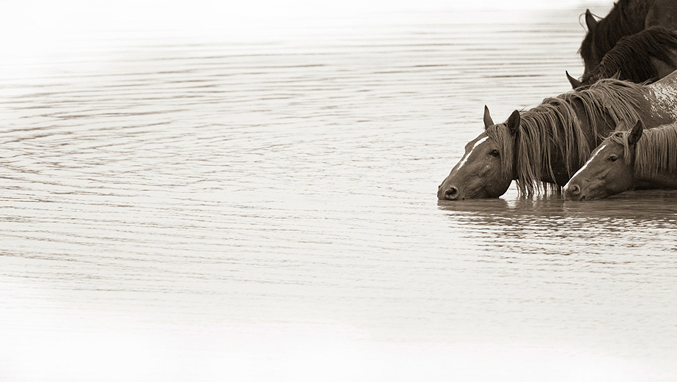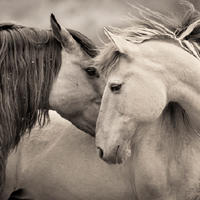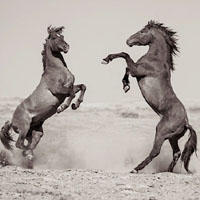"Ripple in the Water" by Kimerlee Curyl
Sickened by the callousness and cruelty she witnessed as a commercial equine photographer, Kimerlee Curyl left security behind and returned to activist fine art photography. Now she drives a pick-up truck far out into Western wilderness rangelands, becoming one with herds of wild horses and returns home with mesmerizing, intimate portraits of the animals in their free spirit and glory. “Success for me is having harmony with my horses in whatever we're doing,” she says.
Curyl’s photographs offer a glimpse into a way of life that’s rapidly disappearing as the Bureau of Land Management (BLM) continues to round up tens of thousands of wild horses with helicopters and herd them into cages every year, costing American taxpayers nearly $80 million last year. Curyl is on a mission to save her wild muse. “If we don’t act to stop these insane, hostile practices, wild horses will soon be gone forever,” she says.
To celebrate the Year of the Horse, I spoke at length with Curyl about her art and her overriding passion to protect a national treasure, a species that has gifted humans transportation, strength, and companionship throughout the ages.
What is it about the wild horse that we resonate so deeply with?
They’re free. In the core of each and everyone one of us, freedom from restraint is our desire. I don’t care who you are. Whatever your personality, at the core, nobody wants to be bound by anything.
There’s just something about the eyes of a horse that you express so well in your photographs.
If you really stop and look into the eyes of a horse, they tell the story of freedom. It’s all right there, and that’s because they’re so in the moment. They don’t think about yesterday or tomorrow. For so many of us today that’s what we are looking for—to live in the moment. The horse is the living embodiment of that.
How do you get these horses to trust you? I mean—they’re wild animals.
I don’t encroach on them from behind. I let them see me coming, and I give them time. There are some herds that are like, “Yeah, you know… not into it.” Of course I want the shot, but I never force anything.
It’s part of the work when you are out there in the middle of millions of acres of territory just waiting. I’ve driven for hours to get there, and sometimes I spend hours to get them to trust me. And guess what? Sometimes they don’t.
I can say when I'm out there I am truly in the moment. Life feels so complete and so authentic in their presence. Horses are so attuned to their environment. Their trust thresholds can start off amazingly huge, but if you have patience and a grounded sense of self, they will let their guard down and let you ‘in.’
I recently received a beautiful email from a woman who attended my photography workshop at Return to Freedom, and she said, “Watching you around wild horses was like watching another one of them.” That was an emotional honor for me.
Tell me about your wild horse photography workshops.
I teach a workshop once a year, along with my good friend Tony Stromberg, at Return to Freedom Wild Horse Sanctuary, a nonprofit organization that takes care of more than 400 wild horses and burros and deals with the current issue at hand. The workshop raises funds and awareness, and I'm proud to be a part of that. Knowledge is key to change, and the broader the awareness, the better for these magnificent creatures.
You are hyper-focused on this issue, aren’t you?
This is my whole life. What I’m striving for is this. What I’m working on is this. I’m either reading about this or working a new show or spending time with the horses. If I’m not spending time on this I’m with my own horses. I will have dinner with my girlfriends and we’ll share stories and a bottle of wine, but that’s my life.
What a wonderful life!
I’m very grateful—but it is also a lot of hard work.
My gallery got a call for a quote from a woman in New York City who said, “Oh well, she must be rolling in the dough.” So the gallery owner started explaining, “Well, she uses museum-quality materials, and they’re all eco-friendly and in very limited editions.” She texted me this as I was sitting in the truck because the winds felt like 70 miles per hour outside, so I called her, laughing of course, and I said, “You call that woman back, and you tell her the only thing I’m rolling in is mud and horse manure!” I had just been laying on the ground trying to get a low-level shot of a magnificent horse drinking, and I was literally rolling about in mud and horse manure.
Your work is both inspiring and informative.
My work is rooted in beauty but it also has elements of education intertwined. The images express the experience of being out there, because most people aren’t going to be able to see what I’ve been able to see.
I’m not going to put everything I’ve seen out there. I photographed a horse with a broken leg even though I knew I wasn’t going to share that with the world. It is painful, and it is part of the fabric of who I am now. So it is in the work but that doesn’t mean I have to share that with the world directly.
So your images are about celebrating life and freedom rather than focusing on capture or captivity or death.
Yes, and I think that’s one of the reasons my work sells especially well in urban environments like New York City and Chicago and Dallas and Los Angeles. I get emails from people who live in the city saying, “I walk in and I see your photograph at the end of the workday and I feel like I can breathe again—when I feel that freedom.”
I love that. I imagine them walking through the concrete jungle all day or sitting in offices working insane hours. Then they get home and see an image of a wild stallion or a herd of wild horses, and that’s inspiring!
My work has a contemporary feel yet it is of a wild, raw animal, which is an unusual mix.
When did you get your first horse?
I didn’t get my first horse until I was 35 (I’m 45 now). I knew very little about horses; I just knew I wanted a horse in my life. I chose a difficult horse—a six year old mare that was very green, more like a three-year-old. I rode a lot of horses, but I just knew she was the one, so certainly she chose me. Maybe we chose each other. When I first rode Sequoia, my mare, my exact words were “Wow, she feels like a butterfly!”
My only goal with Sequoia was for us both to have fun and enjoy each other, but life with a feisty mare can be one heck of a challenge, so I had a ton to learn. Thankfully, I was introduced to Natural Horsemanship early on.
Tell me about Natural Horsemanship.
Natural Horsemanship approaches the horse from the horse’s point of view rather than the human’s point of view. I see so many horses get “sent on down the line” due to simple lack of basic knowledge about what the horse needs and his or her will to survive. It doesn't have to be that way.
Do I dare ask what “sold down the line” means?
Sold or auctioned off or neglected—because some humans think they can't “handle” the horse when really they’re just not listening to their horse. The horse wants only a few simple things: comfort, food, play and love, really. If they’re complicated, it’s only because we complicate things with our human agendas.
Do you see a connection between your early career path in acting and your career now?
In hindsight everything leads you to where you are. The acting moved on to photography work with an orphanage and then from there to wild horses. Also, my last acting coach was how I got into photography, so I suppose there is a connection, yes. She taught me that you can do something even if you don’t have any money.
Tell me about that.
I was an acting student living in Los Angeles. I owned a Pilates studio and was a bartender and a dog walker. Classic, right? For my birthday one year I hung some of my photos of the kids at an orphanage in my studio as an impromptu exhibit. I invited all my friends, and I told people not to bring gifts.
When they came to the show what I kept hearing was, “These pictures are so moving,” and when I counted the money at the end of the day I just couldn’t believe it. We’d raised $1,700 for the children!
That was my first personal experience of the power of art to create change. Art has a voice.
Does your photography focus entirely on wild horses now?
Yes. I once had a thriving part of my business where I was commissioned to photograph famous domestic horses—all these lovely athletes. Horses are no different than human athletes except that they don’t have a say in what they’re doing or how they’re treated. Horses don’t have rights like we do. They don’t have lawyers or agents—or paychecks, for that matter.
They’re considered “property,” which I find bizarre.
They are at our mercy.
I’ve always been an artist at my core, and I thought that photographing beautiful horses would be a beautiful journey to embark upon It was a great paycheck. It lasted about two years.
What happened?
After one particular shoot, what I had seen literally made me sick to my stomach, and I knew that was a message to move on. I knew these people were not breeding anything anywhere near quality in their eyes. There were a lot of them, and they were absolutely beautiful animals but not to the standards these people were judging. On this particular day at this shoot, their attitude was to just get rid of what wasn’t pretty—which often means the feed lot, then the slaughterhouse.
Not everyone conducts their business this way, but this particular day I was sick and very, very sad. I literally got ill (leaning over the toilet vomiting) and I said to myself, “I cannot promote that anymore. OK, Universe, please support me here!” And I took the leap of faith. It was a pivotal moment.
So, slaughter is considered a “solution” for many of these horses?
Slaughter is not a solution. Slaughter is a business. Business generally works on supply and demand, so soon we'll be breeding FOR slaughter, and that is not okay. We have to remember that someone is willing and eager to make a very good living at slaughtering America's horses, and that that horsemeat will not be going to feed starving countries. That horsemeat will go to fine dining establishments to entertain people who want to taste something exotic.
Your star is rising. What if you became famous? You certainly have the talent!
(Laughs) Thank you. That is so kind. I have always said that art has a voice and I hope that voice to gets larger and louder for these horses.
Return to Freedom just held an intimate brunch event with Robert Redford in Santa Barbara. He has come on board to lend his stance and voice to RTF, wild horses on the range and the slaughter issue. He was gifted a piece of my work titled “Unbridled,” which was shot in Utah, the Onaqui herd. I'm honored that he was moved by the piece and this iconic man is so passionate about the issue.
Ellen DeGeneres has also purchased a piece—another amazing powerhouse who is truly rooted in doing serious good in the world. We hope that one day she is able to share this issue on her show. I'm just so grateful the word is spreading, but we still have a ways to go.


